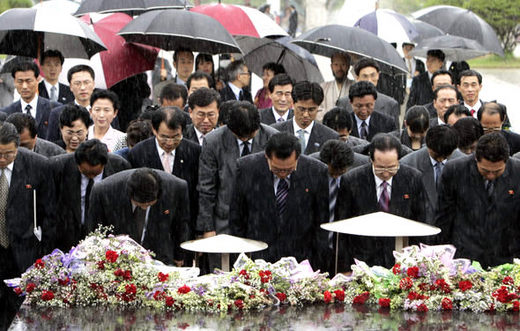Posted on : Jun.15,2006 11:24 KST
Modified on : Jun.15,2006 12:06 KST
 |
|
Members of both North and South Korean delegations pay their respects yesterday to the victims of the 1980 Gwangju pro-democracy uprising at the May 18 Cemetary in Gwangju, South Jeolla province. Kim Jeong-hyo.
|
It has been six years since the historical June 15 Inter-Korean Joint Declaration, issued at the 2000 summit held in Pyongyang between North Korean leader Kim Jong-il and then-president of South Korea Kim Dae-jung. An event is being held in Gwangju until June 17 to commemorate the event.
There has been a lot of progress that came out of the summit. There have been 18 ministerial talks, and a joint committee on economic cooperation has met 12 times since then, as well. In 1999, trade between the North and South totaled 330 million USD. Last year, it exceeded 1 billion USD, and close to 300,000 South Korean tourists visited Mount Geumgang in the North. Seven thousand North Koreans now work at the Kaesong industrial complex, which was built with South Korean capital. Reunions between family members separated by the border between the two Koreas have continued to grow in scale. Essentially, exchange and cooperation has deepened to the point where that part of the relationship does now waver, no matter the situation. You could say that the earliest phase of reunification is underway.
However, on this, the occasion of the sixth anniversary of the declaration, our minds are not at rest. Most importantly, there is still no clear resolution to the North Korean nuclear issue. Deep-rooted distrust and hostility between North Korea and the United States have caused the six-party talks to be stalled for more than seven months. This has led to an imbalance with the progress made in relations between North and South, and that, in turn, has caused a clash between the views of the South and the U.S. If the six-party talks continue to be stalled as they are now, the discord will only grow worse. We need to encourage the North to make realistic decisions and the U.S. to have a more flexible attitude so that the talks can resume. It is for these reasons we are putting our hope in former president Kim Dae-jung’s upcoming visit to Pyongyang.
Inter-Korean relations need to be elevated to a higher level to include areas not previously part of the agenda. So far, relations have been mostly about social and economic interaction, but the relationship is already running into limitations. To start, there needs to be a full-scale discussion of military issues at talks between defense ministers, a format that has remained at a standstill since its first and only meeting. And just as the North will never be able to avoid facing the issue of abducted South Korean citizens, the South needs to respond in a positive manner to the North’s call for a "resolution of fundamental issues."
What both sides need to maintain with consistency is a strong will to achieve reunification, as well as a spirit of realism and mutual respect. When there are differences of opinion, the two sides need to engage in serious dialogue, through which they establish principles and take practical action. Attacking and blaming each other will only reverse the reconciliatory mood that has existed so far. We hope to see the events in Gwangju lead to deeper exchange and cooperation and a new level of relations between the North and South.






